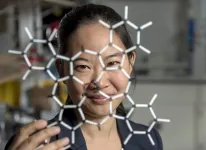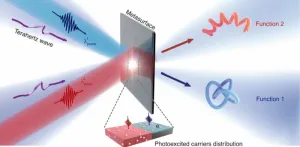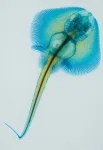(Press-News.org) ITHACA, N.Y. – Can humans endure long-term living in deep space? The answer is a lukewarm maybe, according to a new theory describing the complexity of maintaining gravity and oxygen, obtaining water, developing agriculture and handling waste far from Earth.
Dubbed the Pancosmorio theory – a word coined to mean “all world limit” – it was described in a paper published in Frontiers in Astronomy and Space Sciences.
“For humans to sustain themselves and all of their technology, infrastructure and society in space, they need a self-restoring, Earth-like, natural ecosystem to back them up,” said co-author Morgan Irons, a doctoral student conducting research with Johannes Lehmann, professor in the School of Integrative Plant Science at Cornell University. Her work focuses on soil organic carbon persistence under Earth’s gravity and varying gravity conditions. “Without these kinds of systems, the mission fails.”
The first key is gravity, which Earth life needs to function properly, said co-author Lee Irons, Morgan Irons’ father and executive director of the Norfolk Institute, a group that aims to solve problems of human resilience on Earth and in space.
“Gravity induces a gradient in the fluid pressure within the body of the living thing to which the autonomic functions of the life form are attuned,” he said. “An example of gravity imbalance would be the negative affect on the eyesight of humans in Earth orbit, where they don’t experience the weight necessary to induce the pressure gradient.”
Morgan Irons said that it would be unwise to spend billions of dollars to set up a space settlement only to see it fail, because even with all other systems in place, you need gravity.
Humans and all Earth life have evolved within the context of 1G of gravity. “Our bodies, our natural ecosystems, all the energy movement and the way we utilize energy is all fundamentally based upon 1G of gravity being present,” she said. “There is just no other place in space where there is 1G of gravity; that just doesn’t exist anywhere else in our solar system. That’s one of the first problems we must solve.”
Oxygen is another key factor. Earth’s ecosystem generates oxygen for humans and other life forms. If a technologically advanced primary and a back-up system failed to provide oxygen for the moon base, for example, it would mean instant doom for the astronauts. “A reserve exists everywhere in Earth’s nature,” Lee Irons said. “Think of the hundreds of thousands of species of plants that generate oxygen. That’s the kind of system reserve we need to replicate to be truly sustainable.”
Such an ecological system of an outpost would need an enormous amount energy from the sun. The more distant planets and moons from the sun in our own solar system get decreased amounts of energy.
“You’ll need a lot of energy,” Lee Irons said. “Otherwise powering the ecological system of an outpost will be like trying to run your car on a cell phone battery or probably even worse, trying to run your entire house and household on a cell phone battery.”
For additional information, see this Cornell Chronicle story.
Cornell University has dedicated television and audio studios available for media interviews.
-30-
END
Humans need Earth-like ecosystem for deep-space living
2023-04-12
ELSE PRESS RELEASES FROM THIS DATE:
Nobel Prize-winning immuno-oncology expert receives Block Memorial Lectureship
2023-04-12
COLUMBUS, Ohio – James P. Allison, PhD, is the recipient of the 25th Herbert and Maxine Block Memorial Lectureship Award for Distinguished Achievement in Cancer. A 2018 Nobel Prize co-recipient in physiology/medicine, Allison serves as the chair of immunology and executive director of the Immunotherapy Platform at The University of Texas MD Anderson Cancer Center.
He is a renowned immunologist whose research led to the discovery of the immune system’s T-cell receptor structure and later a molecule ...
UIUC researchers image magnetic behavior at the smallest scales to date
2023-04-12
Permanent magnets, the kind found on refrigerators everywhere, exist because their constituent atoms behave as miniature magnets. They align and combine to form the larger magnet in a phenomenon called ferromagnetism. There are some materials where the atomic magnets instead form an alternating pattern, so the material has no net magnetization. Such antiferromagnets have attracted attention for their potential to create faster and more compact magnetic memory devices for computing.
Realizing the full potential of antiferromagnetic devices will require sensing their atom-to-atom magnetic patterns, ...
Henry Ford Health cardiologists first in US to successfully implant novel tricuspid LuX valve
2023-04-12
DETROIT (April 12, 2023) – Henry Ford Hospital structural heart interventional cardiologists Pedro Villablanca, M.D., and Brian O’Neill, M.D., are the first in the U.S. to successfully implant the new transcatheter tricuspid valve replacement device LuX-Valve Plus™ for the treatment of patients with symptomatic tricuspid valve disease for whom traditional open-heart surgery is too high of a risk.
“These are patients with severe tricuspid regurgitation who have no other options available to them in the U.S., based on the anatomy of their native valve and medical complexities,” ...
Optically controlled metasurfaces for dynamic dual-mode modulation
2023-04-12
Dynamic control of terahertz (THz) waves at-will with an ultracompact device is important for THz technologies in biomedical imaging, telecommunications, detection, and beyond. However, tunable THz devices made of conventional materials are usually bulky, and they tend to have limited modulation depths and functionalities, due to weak interactions between naturally existing materials and THz waves. Metasurfaces – functional materials endowed with unparalleled flexibility to manipulate light at the deep-subwavelength scale – provide ...
Whether physical exertion feels ‘easy’ or ‘hard’ may be due to dopamine levels, study suggests
2023-04-12
Dopamine, a brain chemical long associated with pleasure, motivation and reward-seeking, also appears to play an important role in why exercise and other physical efforts feel “easy” to some people and exhausting to others, according to results of a study of people with Parkinson’s disease led by Johns Hopkins Medicine researchers. Parkinson’s disease is marked by a loss of dopamine-producing cells in the brain over time.
The findings, published online April 1 in NPG Parkinson’s Disease, could, the researchers say, eventually lead to more effective ways to help people establish and stick with exercise ...
Open-label placebo improved outcomes for people in treatment for opioid use disorder
2023-04-12
BOSTON – There were more than 100,000 reported deaths from opioid overdoses in 2021, according to the Centers for Disease Control and Prevention. Methadone treatment remains one of the most reliable means of treating opioid use disorder, with success rates reportedly ranging from 60 to 90 percent for patients who stick with the long-term regimen. Adherence, though, remains a challenge.
In a novel randomized clinical trial published in JAMA Network Open, senior author Ted J. Kaptchuk at Beth Israel Deaconess Medical Center ...
New agreement will help researchers study metal worlds of M-type asteroids
2023-04-12
ORLANDO, April 12, 2023 – A University of Central Florida researcher will be using the newly constructed Two-meter Twin Telescope (TTT) in the Canary Islands, Spain, to study metal-rich M-type asteroids.
The work can inform the study of asteroids like 16 Psyche, an M-type, or metal, asteroid NASA is launching a mission in October 2023 to visit.
The M-type asteroids offer both high concentrations of metals that could be harnessed to make structures in space as well as clues to the formation of ...
Innovative healthcare extension project enables community-based physicians to diagnose autism in young children
2023-04-12
As the number of children in need of access to timely evaluation and intervention for autism spectrum disorder (ASD) continues to rise, new research is showing how barriers to diagnoses and treatment can be reduced through an innovative training program first developed at the University of Missouri.
ASD can be identified and diagnosed in young children by a well-trained clinician, and early diagnosis is vital to quickly establishing access to evidence-based therapies and interventions. However, long specialty center waitlists, distance, and ...
MD Anderson Research Highlights: AACR 2023 Special Edition
2023-04-12
HOUSTON ― The University of Texas MD Anderson Cancer Center’s Research Highlights showcases the latest breakthroughs in cancer care, research and prevention. These advances are made possible through seamless collaboration between MD Anderson’s world-leading clinicians and scientists, bringing discoveries from the lab to the clinic and back.
This special edition features presentations by MD Anderson researchers at the American Association for Cancer Research (AACR) Annual Meeting 2023. In addition to these studies, forthcoming press releases will feature groundbreaking research on perioperative immunotherapy for operable lung cancer (Abstract CT005), ...
Scientists sequence genome of little skate, the stingray’s cousin
2023-04-12
Rutgers geneticists, working with an international team of scientists, have conducted the most comprehensive sequencing yet of the complete DNA sequence of the little skate – which, like its better-known cousin, the stingray, has long been viewed as enigmatic because of its shape.
The scientists, writing in Nature, reported that by studying the intricacies of Leucoraja erinacea’s genome, they have gained a far better understanding of how the fish evolved from its ancestor – which possessed a much narrower body – over a period of 300 million years to become a flat, winged bottom-dweller.
“We ...



